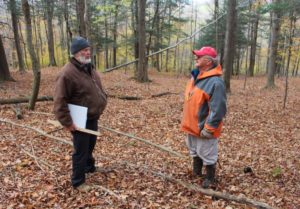How About Those Woodlots; Can We Make Any Money From Them?
Increased farm viability and diversification through value added forest products.
By Rich Taber

Steve Childs of the Cornell Maple Program discussed sugarbush evaluation with Rich Taber of CCE Chenango. Courtesy of CCE Chenango / Small Farms Quarterly.
Many farmers and rural property owners have woodlands as part of their land ownership portfolio, and we oftentimes receive inquiries as to how this land might be developed in order to generate some sources of income. Most landowners own their woodlands for a variety of purposes, such as wildlife viewing, hunting, outdoor recreation, firewood cutting, or maybe because the woods were just there, as part of the property. However, some of these landowners’ livelihoods, and the integrity of the woodlands themselves are at peril due to the recent economic crisis in the dairy industry. CCE Chenango has been working on a grant received from the New York Farm Viability Institute titled “Increased Farm Viability and Diversification through Value Added Forest Products”. The impetus for this project was due to the fact that 66% of New York Farms (23,576) have large amounts of forest lands which add significantly to the purchase prices and tax burdens, and yet less than 2,000 farms use their forest land to generate significant income. 62% of New York’s 30 million acres, about 18 million acres, are covered with forests, and most of this land is owned by private forest landowners, and a good share of that by farmers. Much of this land has the potential to generate income, but is currently underutilized. The purpose of this project is to help farmers and landowners become more profitable and diversified by developing a value-added forest (woodland) enterprise that compliments existing farm operations and which can generate more than $10,000 per year.
One of our original goals in this project was to provide some alternative sources of income to dairy farmers in particular and rural woodland owners in general. The dairy industry has been hit with extremely low farm gate prices for fluid milk of late, with not too rosy a picture in the near future either. Farmers have been receiving prices below the cost of production, and quite simply put a “crisis on the farm exists”!
When prices are as low as they have been, sometimes landowners resort to “selling off the woodlot” for whatever prices they can get for their timber in order to pay their bills. If done incorrectly, the woodlands can be set back for generations before being able to generate any income again. Even if done with correct and sustainable silvicultural practices in place, a woodland can only grow a certain amount of timber, and can only be harvested every 20 years or so. This Extension/Farm Viability project shows that with proper planning a viable woodland oriented income stream can be generated that will provide yearly farm income, and ensure the sustainability of New York’s forests for many years.
The value added products that we have encouraging are maple sap and maple syrup products, firewood and sawtimber production, woodland cultivated mushrooms, campgrounds and rental cabins, and hunting leases. To achieve the goals of this project the following activities have been occurring so far:
- Presentations have been given to farmers across the state to introduce them to farm-compatible forest enterprises that can gross more than $10,000 a year. $10,000 is the minimum gross income level that is required to be generated per year in order for farms to be eligible for property tax reductions.
- Several videos have been produced on forest income producing enterprises and posted to internet and social media sites such as YouTube, Facebook, and Cornell Cooperative Extension Websites. These YouTube videos can be seen at the Cornell Cooperative Extension Chenango County site, as well as at the Cornell Small Farms site with more information about these videos at the end of this article. A few more videos will be added as time allows.
- The project has developed a “Forest Value Added Business Plan Template”, which provides one-on-one help for farmers/landowners developing plans for a value-added forest product enterprise. Several woodland owners have developed viable businesses for their properties with this assistance.
New York State’s forest resources are always at the risk of being sold and subdivided for development. This project aims to keep the landscape in forests by providing farmers and landowners with viable income generating possibilities.
Rich Taber is Grazing, Forestry, and Ag Economic Development Development Specialist with Cornell Cooperative Extension of Chenango County and can be reached at 607-334-5841 ext. 21 or email: rbt44@cornell.edu.
For anyone seeking assistance in developing a forest oriented business contact the following at Cornell Cooperative Extension of Chenango County:
Rich Taber, 607-334-5841, extension 21, email: rbt44@cornell.edu
Ken Smith, 607-334-5841, extension 19, email: kas294@cornell.edu


dogecoin bot is a digital currency which is based on a popular Doge meme. It uses cryptography to secure transactions. The cryptocurrency is one of the top ten cryptocurrencies in terms of market value. In 2013, the dogecoin meme went viral on the internet. People started to throw huge amounts of dogecoins at each other. After that, the price of the token rose dramatically. Some people were convinced that it would become a viable currency.
It is inspiring to see efforts to sustainably leverage woodlands for income diversification especially amid economic challenges in the dairy industry. Rich Tabers initiative seems promising for both farmers and forest preservation.
Custom Built Cabinet in Leawood KS